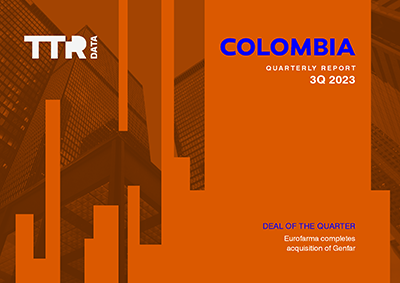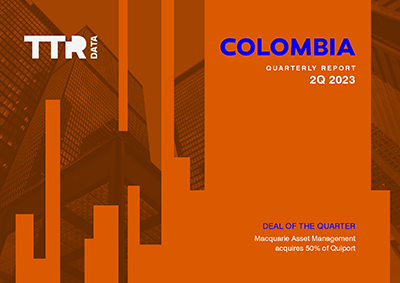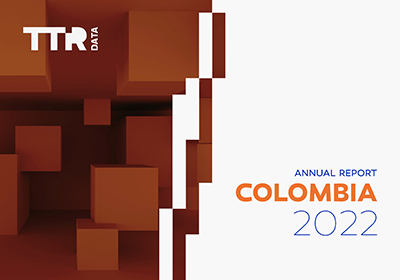Content available in English and Spanish (scroll down)
TTR Dealmaker Q&A with Gómez-Pinzón Partner Felipe Mariño
Gómez Pinzón
Felipe Mariño
Felipe es socio de la firma Gómez-Pinzón Abogados y cuenta con más de 15 años de experiencia profesional, en los que se ha especializado en transacciones de derecho inmobiliario, fusiones y adquisiciones e infraestructura. Asesora, tanto en operaciones locales como cross-border, a algunos de los grupos económicos, fondos inmobiliarios y fondos de capital privado más importantes del país.
TTR: How would you describe the current situation of the players in the M&A market in Colombia with the current regional political and economic situation in this year?
GP: The current political and economic context in the region is having different impacts on the players of the local M&A market. In the specific case of Colombia, this situation includes historic rises in the interests rates, an accumulated inflation for the year 2022 of approximately 11%, a devaluation of the Colombian Peso of approximately 23% against the American Dollar and a significant degree of uncertainty regarding regulatory changes in certain industries. The main impact that we have been observing is the lack of appetite of certain players for the sectors and industries primarily affected by the current situation, like the mining industry, and an increased interest in “safer” industries such as education, healthcare, renewable energies and telecommunications infrastructure. Another impact that we have identified is how the high interest rates has made the acquisition of assets less appealing for certain investors, which are now preferring to fund their transactions fully with equity and others are simply awaiting an improvement in the conditions of the financial market to undertake new investments.
Notwithstanding the foregoing, not everything is negative. The historical rises that we have observed in the exchange rate has favorably affected foreign investors’ financial capacity, thus making more attractive the acquisition of assets in the region for such investors in terms of acquisition price. Moreover, the performance of the Colombian economy (with an annual growth of 9.7% for the year 2022) in comparison to other Latin American economies, together with the overall size of our economy, enables Colombia to maintain its position as an attractive country for M&A players. For instance, unlike other years in which electoral uncertainty customarily had the effect of decelerating M&A activity during the months prior to the presidential election, the first semester of 2022 was very dynamic. Based on the data provided by TTR, during the first semester of 2022 there were 18 more deals closed than during that the same time period in 2021 (111 transactions were reported for the first semester of 2021 and 129 transactions were reported for the first semester of 2022). We expect this trend to continue until the end of the year. We clearly expect the next year to bring new challenges for key players in the M&A market, but we are confident that the positive trend shown by the market is maintained, that the new government is every day more conscious of the uncertainty created by their regulatory measures for investors and that the regional economy continues to progressively adjust to the new global context, especially in terms of interest rates, volatility, among other factors.
TTR: What are the most relevant drivers for consolidating the Latinamaerican M&A market in the next months?
GP: In line with the previous question, we believe the most relevant drivers for the consolidation of the M&A market in Latin America are, firstly, the reaction of the business sector to the regulatory changes that the new governments want to implement (especially regarding tax and energy matters), and in second place the behavior of macroeconomic factors and indicators that are critical for the business environment, such as inflation and devaluation. For a fluent and dynamic M&A market to foster in the region, a healthy business sector is essential, in a framework of economic and legal security and stability. If these two factors do not converge, a consolidation of the regional M&A market for the next few years will be very difficult.
TTR: In which sectors might international investors find the biggest opportunities in Colombia? Why?
GP: Based on the market´s behavior for the last couple of years and until the new government took office in Colombia, the sectors that were offering the biggest investment opportunities and thus experiencing a higher number of M&A transactions had been energy, infrastructure, transportation, telecommunications, healthcare, technology and fintech. However, considering the tendencies reflected by the new government on their economic and entrepreneurial public policies, we can reasonably except that the main opportunities in Colombia for international investors in the next few years will be in sectors such as renewable energies, agribusiness and technology.
TTR: How will the conflict between Russia and Ukraine impact the energy sector, and what does this mean for the regional M&A market?
GP: The conflict between Russia and Ukraine has entailed many economic repercussions worldwide beyond the energy issues. However, from an M&A perspective this situation can create significant business opportunities for countries in the region that are producers and exporters of fossil fuels and other commodities, such as Colombia. The global rise of prices for oil, gas, coal and other commodities as a consequence of the conflict between Russia and Ukraine is forcing the main stakeholders in these sectors to seek alternative regions for exploration and exploitation. This can have a very positive impact on the Latin American market in terms of foreign investment, which is customarily accompanied by an increase in M&A activity.
TTR: What will Gómez Pinzón main challenges be in terms of M&A deals in the colombian market in the next months?
GP: The main challenge in the current scenario is reaching a balance between aiding our clients in closing their deals in the most efficient and agile manner in a context of very strong uncertainty, and nevertheless continue to convey a message of stability and trust in the legal institutions of our country. Various economic sectors are facing very strong uncertainty as a consequence of the regulatory views of the new government on certain topics, especially in oil and gas, mining and healthcare. Thus, we can reasonably expect a decrease in investment and M&A transactions in these sectors in the upcoming years. Additionally, the tax reform that the new government wants to implement also entails significant challenges for the business sector. Particularly, the increase in the occasional gains tax rate can have a direct impact on M&A transactions, as it can disincentivize the sale of companies and assets in Colombia as a consequence of the additional tax burden for selling parties. We can also expect a significant decrease of privatizations (sale of state-owned companies to private parties) considering the economic and political views of the new government, and an increase in M&A activity between state agencies and entities, which will entail a significant challenge from a legal practice perspective for M&A practitioners.
Spanish version
Gómez Pinzón
Felipe Mariño
Felipe es socio de la firma Gómez-Pinzón Abogados y cuenta con más de 15 años de experiencia profesional, en los que se ha especializado en transacciones de derecho inmobiliario, fusiones y adquisiciones e infraestructura. Asesora, tanto en operaciones locales como cross-border, a algunos de los grupos económicos, fondos inmobiliarios y fondos de capital privado más importantes del país.
TTR: ¿Cómo describe la situación actual de los players del mercado M&A en Colombia con la actual coyuntura política y económica regional en el año?
GP: La actual coyuntura política y económica regional ha tenido distintos impactos en los jugadores del mercado local de M&A. En el caso particular de Colombia, esta coyuntura cual incluye alzas extraordinarias en las tasas de interés, una inflación acumulada de alrededor del 11% en el 2022, una devaluación del peso de alrededor del 23% frente al Dólar y un grado importante de incertidumbre en cuanto a cambios regulatorios en ciertas industrias. El impacto más evidente que se ha observado es la falta de apetito de algunos jugadores por sectores e industrias que se han visto más afectados por toda esta situación, como lo es la minería, y por otra parte el mayor apetito por sectores e industrias un poco más “seguras” como son el sector educativo, salud, energías renovables e infraestructura de comunicaciones. Otro de los impactos que hemos observado es que con las altas tasas de interés la financiación para la compra de activos ha dejado de ser atractiva para ciertos inversionistas, algunos de los cuales han simplemente optado por realizar las adquisiciones a través de equity y otros han tenido que esperar que las condiciones del mercado financiero mejoren para poder realizar ciertas inversiones.
No obstante lo anterior, no todo es negativo. Los incrementos históricos que hemos observado en la tasa de cambio han afectado favorablemente la capacidad adquisitiva de los inversionistas internacionales, razón por la cual la adquisición de activos en el país se ha vuelto más atractiva para los capitales del exterior, en términos de precio. Así mismo, el comportamiento de la economía colombiana (con un crecimiento anual de 9.7% en lo que va corrido de 2022) comparada contra otras economías latinoamericanas, así como el tamaño de nuestra economía, que sigue siendo relevante frente a otros países de la región, hace que Colombia siga siendo un país atractivo para los jugadores de M&A. Por ejemplo, a diferencia de otros años en los cuales la incertidumbre electoral usualmente generaba el efecto de desacelerar la actividad de M&A en los meses previos a la elección presidencial, el primer semestre del 2022 fue bastante movido. De acuerdo con las bases de datos de TTR, durante el primer semestre del 2022 se cerraron en el país 18 transacciones más que durante el mismo período del año 2021 (se reportaron 111 transacciones para ese período en el año 2021 y 129 para el primer semestre del 2022), y se espera que esta tendencia se mantenga hasta finalizar el año. Por supuesto, el próximo año traerá sus propios retos para los jugadores de M&A, pero confiamos en que el impulso que trae el mercado en cierta medida se mantenga, nuestro gobierno sea cada vez más consciente de la incertidumbre que generan ciertas medidas para los inversionistas y la economía regional se vaya ajustando poco a poco en términos de tasas de interés, volatilidad, entre otros.
TTR: ¿Cuáles serán los drivers más relevantes para la consolidación del mercado M&A latinoamericano en los próximos meses?
GP: En línea con la pregunta anterior, creemos que los principales drivers para la consolidación del mercado de M&A latinoamericano son, en primer lugar, la reacción que tenga el sector empresarial a los cambios regulatorios que implementen los nuevos gobiernos (particularmente en materia tributaria y energética), y por otro lado el comportamiento de factores e indicadores macroeconómicos de alto impacto para el clima de negocios como la inflación y la devaluación. Para que pueda desarrollarse un mercado de M&A fluido y dinámico en la región, es necesario que el sector empresarial se esté desarrollando de manera saludable, dentro de un marco legal y económico de seguridad y estabilidad. En la medida en que estos factores no confluyan, será difícil que el mercado de M&A en la región se consolide de manera significativa en los próximos años.
TTR: ¿Cuáles serían los sectores que podrían ofrecer las mayores oportunidades en Colombia a los inversores internacionales y por qué?
GP: Si tenemos en cuenta el comportamiento del mercado en los últimos años y hasta antes del cambio de gobierno en Colombia, los sectores que estaban ofreciendo mayores oportunidades de inversión y por ende mayor dinamismo a nivel de operaciones de M&A han sido los sectores de energía, infraestructura, transporte, telecomunicaciones, salud, tecnología y fintech. Sin embargo, con base en las inclinaciones del nuevo gobierno en sus políticas públicas en materia económica y empresarial, podemos esperar razonablemente que en los próximos años las principales oportunidades para los inversionistas internacionales se presenten en sectores como energías renovables, agroindustria y tecnología.
TTR: ¿Cómo afectará el conflicto entre Rusia y Ucrania al sector energético y qué significa esta coyuntura para el mercado de fusiones y adquisiciones en la región?
GP: El conflicto entre Rusia y Ucrania ha tenido muchas repercusiones económicas a nivel mundial más allá del tema energético. Sin embargo, desde la perspectiva del mercado de M&A esta coyuntura puede generar oportunidades de negocio significativas para los países de la región que son productores y exportadores de hidrocarburos y otros commodities,tales como Colombia. El alza global en los precios del crudo, del gas, del carbón y de otros commodities como consecuencia del conflicto entre Rusia y Ucrania está forzando a que los actores principales en estos sectores busquen regiones alternativas de exploración y explotación, lo cual puede tener implicaciones favorables para el mercado latinoamericano en materia de inversión extranjera y por ende un aumento en la actividad de M&A en la región.
TTR: ¿Cuáles serán los principales retos para Gómez Pinzón en términos de transacciones de M&A en el mercado colombiano para los próximos meses?
GP: El principal reto en la coyuntura actual es lograr un equilibrio entre ayudar a nuestros clientes a cerrar sus transacciones y proyectos de la manera más ágil y eficiente posible considerando el panorama de incertidumbre que existe en el mercado, pero sin dejar de transmitir un mensaje de estabilidad y confianza en las instituciones legales de nuestro país. Estamos observando un alto nivel de incertidumbre en ciertos sectores económicos por las visiones regulatorias que ha planteado el nuevo gobierno en estos temas, especialmente en hidrocarburos, minería y salud. Por ende, podemos esperar razonablemente que la inversión y la actividad de M&A en estos sectores se vea disminuida en los próximos años. Adicionalmente, la reforma tributaria que quiere implementar gobierno también genera varios desafíos para el sector empresarial. En particular, el aumento de la tarifa de ganancia ocasional tiene un efecto directo en las operaciones de M&A ya que puede desincentivar la venta de empresas y activos en Colombia al aumentar el impacto fiscal para el sell-side. También podemos esperar que disminuyan considerablemente las privatizaciones (venta de empresas de propiedad estatal a particulares) en los próximos años, teniendo en cuenta las visiones económicas y políticas del nuevo gobierno, y que se incremente la actividad de M&A entre entidades o empresas del estado, lo cual va a generar un desafío desde un punto de vista de práctica jurídica para los abogados de M&A.






